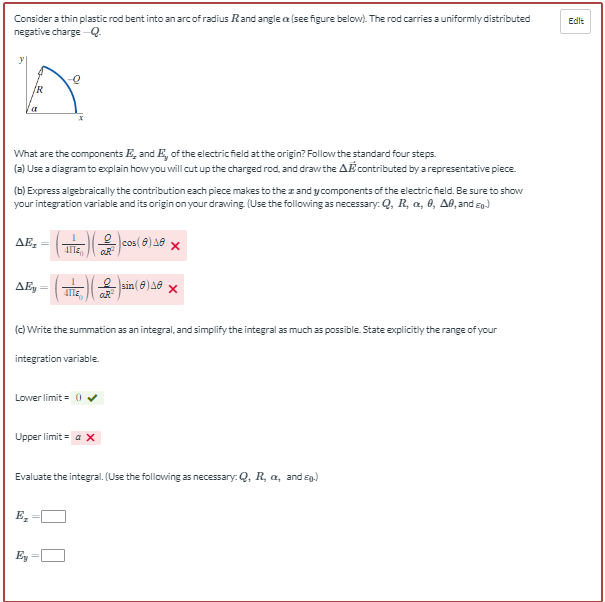Home /
Expert Answers /
Advanced Physics /
consider-a-thin-plastic-rod-bent-into-an-arc-of-radius-r-and-angle-alpha-see-figure-pa909
(Solved): Consider a thin plastic rod bent into an arc of radius \( R \) and angle \( \alpha \) (see figure ...
Consider a thin plastic rod bent into an arc of radius \( R \) and angle \( \alpha \) (see figure below). The rod carries a uniformly distributed negative charge - \( Q \) - What are the components \( E_{x} \) and \( E_{y} \) of the electric field at the origin? Follow the standard four steps. (a) Use a diagram to explain how you will cut up the charged rod, and draw the \( \Delta \vec{E} \) contributed by a representative piece. (b) Express algebraically the contribution each piece makes to the \( x \) and \( y \) components of the electric field. Be sure to show your integration variable and its origin on your drawing. (Use the following as necessary: \( Q, R, \alpha, \theta, \Delta \theta \), and \( \varepsilon_{0} \) ) \[ \begin{array}{l} \Delta E_{x}=\left(\frac{1}{4 \Pi \varepsilon_{0}}\right)\left(\frac{Q}{\alpha R^{2}}\right) \cos (\theta) \Delta \theta \times \\ \Delta E_{y}=\left(\frac{1}{4 \Pi \varepsilon_{0}}\right)\left(\frac{Q}{\alpha R^{2}}\right) \sin (\theta) \Delta \theta \times \end{array} \] (c) Write the summation as an integral, and simplify the integral as much as possible. State explicitly the range of your integration variable. Lower limit = Upper limit = Evaluate the integral. (Use the following as necessary: \( Q, R, \alpha \), and \( \varepsilon_{0} \).) \[ E_{x}= \] \[ E_{y}= \]
